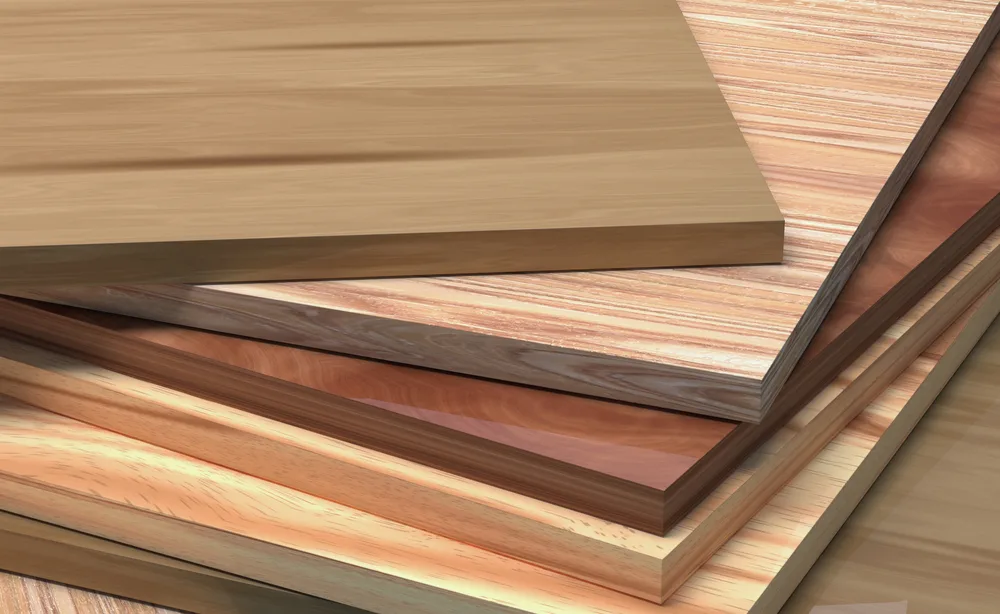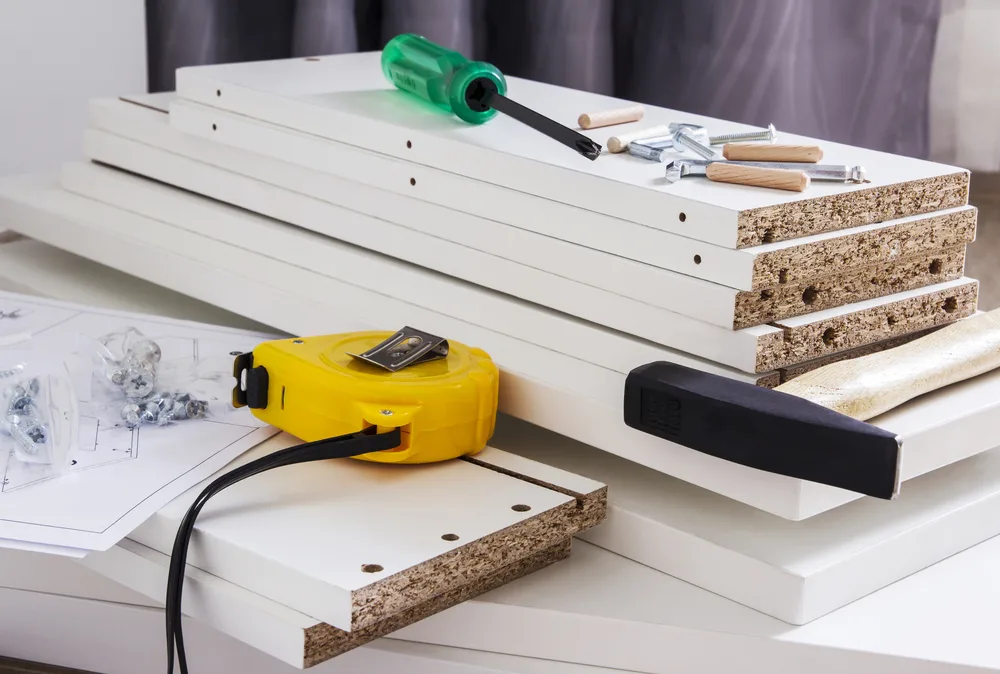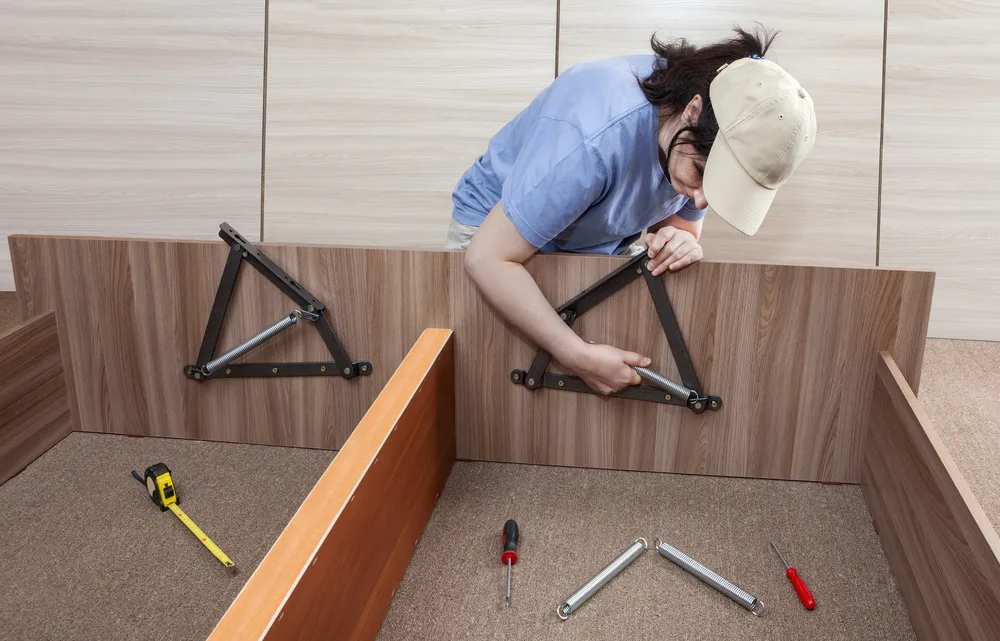IKEA’s prices and the mixed reviews for some products can make you wonder what their products are actually made of. You’d not be the first to ask whether these items are worth your time and money. You may also be wondering about the environmental impact of all that low-cost, mass-produced furniture.
IKEA has a wide variety of materials for you to choose from. These, in turn, vary in quality, durability, and cost. What they all have in common is IKEA’s mission for sustainability. Let’s discover what exactly hides inside the IKEA furniture!

The most commonly used materials are particleboard and fiberboard. IKEA also offers a variety of solid wood products, metal, plastic, or fabric products. They often use recycled wood and plastic or sustainable materials such as responsibly sourced cotton, wool, bamboo, and other natural fibers.
The Most Frequently Used Material Is Particleboard

Much of the material used in wood-based IKEA products is particleboard and some medium-density fiberboard (MDF). These engineered woods are the foundation of the furniture empire.
Particleboard (low density) is comprised of sawdust, wood shavings, and wood chips that are glued together. MDF is a mixture of softwood and hardwood by-products bonded together with waxes and resins at high pressures and temperatures to create boards.
The adhesives used to create these boards contain formaldehyde, which often causes the furniture to smell. The good news is there is a way to remove the smell from your furniture.
MDF is considered stronger than particleboard, but the latter is the main backbone of IKEA’s furniture.
Why? Well, it comes down to cost. Particleboard is predominantly composed of small wood particles (dust), while fiberboard is made from small pieces (fibers) of wood, which makes MDF more expensive. Once surfaced, there is very little difference in appearance between the two materials.
IKEA mainly uses these materials to give customers cheap furniture options that still look good. These materials are also light, making them relatively easy and cheap to transport while also being low-maintenance, more customizable, and less prone to warping than solid wood.
Unfortunately, the quality reflects the price. These engineered boards are not as durable or strong as solid wood products. Therefore, they are prone to wear and water damage, and they shred and break easily during assembly and use. The average lifespan of IKEA products made from particleboard and MDF is 4-8 years.
You also need to consider the limitations in use resulting from the lower-quality materials. For example, storing a fish tank on an MDF unit could end in disaster due to the weight of the water-filled tank and water-related damage.
Does IKEA Use Real Wood?
While IKEA uses the cheaper engineered woods, it also offers a wide variety of more traditional wood products. This includes both solid woods and wood veneers, giving you a choice of many different types of wooden products at different price points.
Solid Wood
Solid wood products are considered to be of better quality than engineered wood products. Solid woods are strong, durable, and long-lasting. IKEA uses several different kinds of both hardwood and softwood, including:
- Pine
- Acacia
- Oak
- Beech
- Birch
The biggest advantage of solid wood is its durability. It can last decades longer than the veneer counterparts because of what is below the surface. It also has its distinctive sleek and elegant look that is timeless and hard to match.
The main disadvantage of solid wood items is how much you have to pay. Solid wood furniture is expensive. It also requires plenty of maintenance to protect the wood from moisture damage and mold. Also, the wood can become damaged by changing temperatures, pest infestations, and incorrect maintenance.
Wood Veneer
Wood veneer is a thin sheet of wood that is designed as a cover for composite materials like particleboard and MDF. This gives the composite material a cleaner, more elegant look of solid wood without the higher price tag.
IKEA uses a range of woods for veneers, which includes:
- Ash
- Birch
- Pine plywood
- Oak
Veneers are prone to scratching and denting. Once they become damaged, they can quickly lose that solid wood elegance. In addition, they cannot be sanded down to fix surface damage (unlike solid wood). Veneers also have lower loadbearing capability than solid wood.
However, wood veneer can be used to create beautiful furniture that looks like solid wood. It doesn’t warp and split if cared for and is highly durable. In addition, it is affordable and readily available, allowing people to achieve their décor dreams with a limited budget.
Are IKEA Products Good Quality?

As is the case with most goods, you get what you pay for. IKEA has some categories and products that are made cheaper at the cost of quality. They will not be as sturdy, durable, and well-made as some of the other IKEA products.
Solid wood and steel products are more expensive; however, they are generally high quality and will last longer.
IKEA Materials and Sustainability
In more recent years, IKEA has moved towards sustainability in both its materials and its products. This is a part of the company’s green initiative and environmental responsibility.
in the product information for each item, IKEA provides a list of materials (including recycled materials) that are used in the manufacturing process. This shows that they are happy to be transparent with customers about what they are really buying.
Materials They Use
- IKEA advocates the use of sustainable and renewable resources like bamboo, cotton, and wool in its manufacturing.
- Wood and bamboo are sourced with Forest Stewardship Council (FSC) approval to ensure that the raw material is obtained from sustainable sources with responsible forest management.
- Recycled wood is used to reduce the amount of new timber needed in manufacturing.
- IKEA strives to use as much recycled plastic as possible in its manufacturing to do its part in reducing plastic waste.
- IKEA uses naturally flame-retardant materials in manufacturing to help reduce the need for chemical usage.
Things They Avoid
As part of its sustainability movement and to protect consumers’ health, IKEA has minimized the use of chemicals in the manufacturing and transportation of their products. And the chemicals it does use are approved and heavily regulated.
There are several things that IKEA avoids using in their products:
- Harsh chemicals that don’t comply with laws and regulations for health and safety.
- Lead.
- Formaldehyde, aside from naturally occurring trace amounts.
- PFOA or PFAS chemicals. IKEA doesn’t allow these chemicals to be added during manufacturing.
- Flame-retardant chemicals. Where required by some countries, IKEA treats according to legal requirements and ensures the products meet emission requirements.
- BPA. According to information from IKEA, this chemical is banned in products that will be in contact with food and children’s products. BPA is an endocrinological toxin, meaning that it interferes with proper hormonal activity and control.
IKEA Combines Materials

Combining composite particleboards and/or fiberboards with unblended components like veneers, glass, plastic, and metal is very common in IKEA products. It keeps the cost down while providing the material with the desired look.
To find out precisely which materials were used to manufacture the furniture, simply find your product on IKEA’s website, click on “Product details,” and look under “Materials & care.”
7 Types of Materials With Examples
Below is a list of materials you can frequently find while browsing IKEA, as well as some of the products made of these specific materials.
1. Composite
Composite materials are one of the ways that IKEA can keep furniture affordable. You will find fiberboard products throughout the IKEA store either combined with a veneer or layered with other materials on this list.
Composite is made up of two or more materials with different attributes to make it strong and cheap. This fiberboard is found in bookshelves, shelving, cabinets, cupboards, and drawers.
The famed BILLY bookcases and MALM desks from IKEA are made from composite materials: particleboard and fiberboard with an ash veneer.
2. Wood
IKEA has a variety of products made with softwood:
- Pine
- Beech
- Spruce
IKEA also offers options with hardwood:
- Birch
- Oak
- Acacia
- Eucalyptus
- Ash
You will find solid woods in bed frames, cabinets, chests of drawers, and shelving categories. Wooden veneers can also be found throughout IKEA’s catalog.
The ESPEVÄR mattress base is made of solid spruce and pine, while the TORNVIKEN kitchen island is made with both solid oak and oak veneer.
3. Bamboo
Bamboo is a grass that is durable, strong, and water-resistant. Pair this with how quickly the plant grows, and it makes an excellent renewable resource for furniture manufacturing.
IKEA uses bamboo in three ways:
- Natural fibers: bamboo will be rolled, pressed, or weaved for use in IKEA products.
- Industrialized: bamboo is split into layers and glued together into boards in this form.
- Layer glued: this is made with layers of bamboo glued into a veneer.
You will find bamboo products across many IKEA categories: from shelving to plant holders, to kitchen accessories, to storage boxes and baskets. The RÅGRUND shelving unit is an example of one bamboo item.
4. Metal
IKEA uses two metals that are affordable and durable:
- Steel
- Aluminum
You will find many steel products in the outdoor furniture section of IKEA. Or in bed frames like the SVÄRTA bunkbed frame.
There are also multiple smaller products made of steel, including metal drawers and curtain and towel rods like the RÄCKA curtain rod. You will commonly find that this steel has a protective plastic powder coating.
Aluminum is found almost exclusively in the outdoor furniture section in the form of tables, chairs, and umbrellas, for example, the SJÄLLAND table set.
5. Plastic
There are three main plastics used in IKEA’s manufacturing:
- PET (polyethylene terephthalate, or polyester)
- PP (polypropylene)
- PE (polyethylene)
IKEA aims to use plastic that is renewable or recycled. For example, the VARIERA box for storage and organization is made from PET, with a minimum of 20% of that being recycled plastic (mainly plastic bottles).
Plastics are also used in various other products: as plastic foil covers for cupboard doors, in combination with wood for items like chairs, and it can even be used in fabrics.
6. Fabric
IKEA maintains its bid for sustainable materials with fabrics. The two main raw materials used in IKEA fabrics are:
- Cotton
- Wool
The cotton is obtained from sources that minimize damage to the environment and surrounding communities. This is achieved by reducing the fertilizers and pesticides used with the crops and also by using better cultivation methods and water management.
In addition, IKEA obtains wool from suppliers that comply with guidelines for responsibly-sourced wool.
You will see wool and cotton across product categories like couch covers, pillow covers, blankets, linens, and rugs, such as the BUDDINGE rug.
7. Natural Fibers
Some of the materials used in IKEA furniture are made of natural fibers, which IKEA promotes as being a renewable resource. The natural fibers that IKEA uses in its woven products are:
- Water hyacinth
- Banana fibers
- Rattan
- Cork
- Bamboo
Rattan is frequently used in IKEA outdoor furniture, armchairs, and various storage and laundry baskets. For example, the INSVEP basket.
You will find cork mainly in the decoration, kitchen accessory, and organization categories in the form of potholders and jar lids, such as the SAXBORGA jar with lid and tray. However, you will find it sparingly in a few other places, like cabinet doors.
Sources
https://www.upcyclist.co.uk/2018/05/ikea-recycled-plastic-homeware/
https://omnexus.specialchem.com/selection-guide/polyethylene-terephthalate-pet-plastic
https://omnexus.specialchem.com/selection-guide/polyethylene-plastic
https://omnexus.specialchem.com/selection-guide/polypropylene-pp-plastic
https://www.thespruce.com/ikea-kitchen-cabinets-are-made-of-1822041#
https://www.ikea.com/us/en/customer-service/faq/
https://www.thespruce.com/what-is-mdf-1398198
https://homeguides.sfgate.com/difference-between-particle-board-medium-density-fiberboard-99189.html
https://www.popularwoodworking.com/projects/mdf-vs-particleboard/
https://www.paradeofhomes.org/blog/mdf-solid-wood-furniture-advantages-disadvantages/
https://www.thebasicwoodworking.com/what-is-wood-veneer/
https://www.ikea.com/gb/en/this-is-ikea/about-us/wood-a-material-with-many-qualities-pubd4deffde
https://www.woodworkingnetwork.com/wood/wood-month/what-you-need-know-about-bamboo
